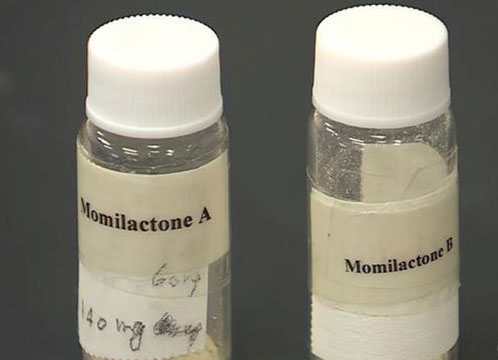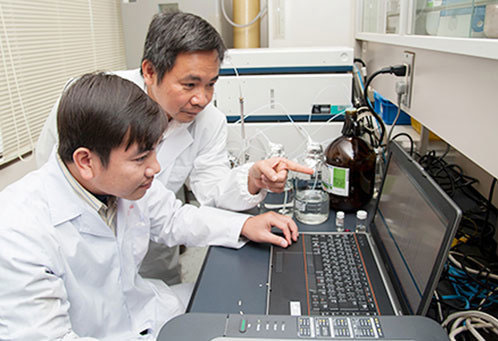Professor Dr. Trần Đăng Xuân and his team have demonstrated that the compounds Momilactones A and B found in rice promote the apoptosis of blood cancer cells by regulating specific proteins.
The research, led by Professor Dr. Trần Đăng Xuân, Head of the Plant Physiology and Biochemistry Laboratory at Hiroshima University (Japan), along with colleagues including Assistant Professor Dr. Nguyễn Văn Quân, Dr. Lã Hoàng Anh, Professor Dr. Takami Akiyoshi, and Master Vũ Quang Lâm from Aichi Medical University, was published in the journal Cancers in early October, highlighting the potential of Momilactone A and B (MA and MB) extracted from rice as a treatment for blood cancer.

Momilactones A and B extracted at the Plant Physiology and Biochemistry Laboratory, Hiroshima University. (Photo: Provided by the laboratory)
In this study, scientists have for the first time demonstrated the potential of Momilactones A and B (MA, MB) and their mixture (MAB) in killing blood cancer cells, including acute myeloid leukemia and multiple myeloma. Specifically, MB and MAB exhibited superior inhibition of cancer cell growth compared to the common chemotherapy drugs doxorubicin and arsenic trioxide (ATO), and were comparable to all-trans retinoic acid (ATRA).
Through in-depth experiments, Professor Trần Đăng Xuân and his team clarified the mechanism by which momilactone kills cancer cells. Specifically, these compounds can promote the apoptosis of cancer cells by regulating related proteins (p-38, BCL-2, and caspase-3). Additionally, momilactone can halt the cell cycle at the G2 phase by activating the p-38 protein and inhibiting the activity of the CDK1 and cyclin B1 complex. In this way, momilactone prevents cancer cells from dividing. Notably, momilactone has shown minimal impact on healthy cells.
The discovery of the cytotoxic properties of momilactone against cancer cells is expected to pave the way for future research and development of effective cancer treatment drugs based on momilactone.
The team stated they will continue research on the bioavailability and biological accessibility of these compounds through trials before proceeding to clinical trials.
Previously, some studies had indicated the anticancer potential of momilactones; however, the mechanisms of their cytotoxic action had not been thoroughly investigated. The lack of in-depth studies on this compound globally is attributed to its rarity, as this compound is “30,000 times more expensive than gold” and is not readily available in the market, along with the challenges of isolation and purification.
The Plant Physiology and Biochemistry Laboratory at Hiroshima University, led by Professor Xuân, is one of the few laboratories in the world capable of refining momilactones from natural sources.

Professor Trần Đăng Xuân (right) and researchers at the Plant Physiology and Biochemistry Laboratory. (Photo: Hiroshima University).
In a publication from January 2019, the team successfully identified and isolated these two compounds from rice husks and white rice. From 20 kg of rice husks, approximately 300 mg of MA and 200 mg of MB (accounting for about 1/100 – 150 thousand of the weight of the rice husks) were extracted after nearly three months. This compound was previously listed on Carbosynth.com, a renowned British biochemical products company, for $1.25 million per gram (30,000 times the value of 1 gram of gold). In subsequent studies, these valuable compounds also showed the ability to inhibit diabetes and obesity.


















































